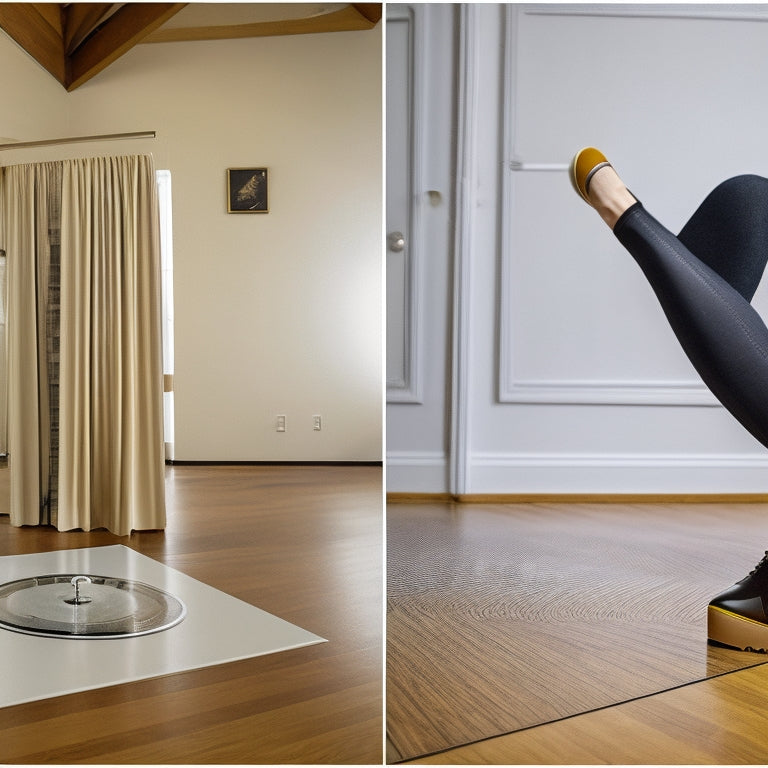
Can You Tap Dance on Vinyl Plank Flooring?
Share
You can tap dance on vinyl plank flooring, which is designed to withstand the demands of high-energy routines. The durable surface provides a low-maintenance space for dance practice and performance. With its multi-layered construction, vinyl plank flooring can resist scratches and fading, making it an ideal choice for tap dancing. As you take your first steps, you'll appreciate the flooring's sound-absorbing qualities and waterproof core. However, be sure to take safety precautions, such as wearing proper dance shoes and inspecting the floor regularly. As you continue, you'll discover more about the benefits and considerations of tapping on vinyl plank flooring.
Key Takeaways
• Vinyl plank flooring is durable and resistant to scratches and wear from tap dancing, making it an ideal choice for dance studios and home practice spaces.
• Regular floor inspections and prompt addressing of scratches or damage are crucial to maintaining the flooring's top condition.
• Vinyl plank flooring provides a smooth, consistent surface for intricate footwork and can accommodate high-energy tap dance routines.
• It is essential to choose flooring with sound-dampening features and add sound-reducing underlayment to minimize noise levels and prevent disturbing neighbors.
• Many dance studios and professional tap dancers have successfully installed and performed on vinyl plank flooring, showcasing its suitability for tap dancing.
Understanding Vinyl Plank Flooring
Examine the composition of vinyl plank flooring, and you'll discover a multi-layered construction that typically includes a waterproof core, a decorative layer, and a wear layer.
This innovative design is a proof of the vinyl evolution, which has led to significant flooring innovations.
The waterproof core provides a durable and moisture-resistant foundation, while the decorative layer showcases a realistic wood or stone pattern.
The wear layer, usually made of clear vinyl, protects the flooring from scratches and fading.
As you consider tap dancing on vinyl plank flooring, it's crucial to understand the intricacies of this flooring type.
Tap Dance Impact on Floors
As you consider tap dancing on vinyl plank flooring, you'll want to weigh the potential risks to your floor.
You'll need to think about the likelihood of damage to your flooring, the noise level impact on those around you, and the durability concerns that come with repeated tapping.
Floor Damage Risk
When you tap dance on vinyl plank flooring, the repetitive impact of your heels and toes can cause significant stress on the floor, leading to potential damage and wear. This can result in costly repairs or even void your damage warranty.
Before you start tapping, it's essential to inspect your floor for any signs of weakness or damage. Regular floor inspections can help identify potential issues before they become major problems.
You might be left with a damaged floor that's no longer under warranty.
You could be faced with expensive repair bills.
Your freedom to dance could be restricted by the fear of damaging your floor.
Noise Level Impact
You'll be dealing with more than just floor damage when you tap dance on vinyl plank flooring, as the noise level impact can be a substantial concern for homeowners who live in apartments, condos, or share walls with neighbors. The constant tapping can be disturbing to those around you, and you may face noise complaints or even fines if you violate noise regulations.
| Soundproofing Solution | Effectiveness |
|---|---|
| Area Rugs | Moderate |
| Interlocking Foam Tiles | High |
| Mass Loaded Vinyl | Very High |
| Acoustic Underlayment | Highest |
To minimize disturbance, consider using soundproofing materials like area rugs, interlocking foam tiles, mass loaded vinyl, or acoustic underlayment. These solutions can greatly reduce the noise level impact of your tap dancing, ensuring you can practice freely without disturbing others.
Durability Concerns
Tap dancing on vinyl plank flooring can lead to significant durability concerns, as the constant impact of your metal plates can cause scratches, dents, and even cracks on the floor's surface. This is especially true if you're performing complex or high-energy routines, as the repetitive stress can exacerbate Vinyl Weakness.
Your Floor Expectations may not align with the reality of damaged flooring.
- You may be left with costly repairs or even replacement of the entire floor.
- The damage can be a significant setback for your tap dancing practice or performances.
- The stress and worry of damaging your floor can hinder your freedom to fully express yourself through dance.
Durability of Vinyl Plank
By installing vinyl plank flooring, you're investing in a highly durable surface that can withstand the rigors of frequent foot traffic and intense activities like tap dancing.
Vinyl plank flooring is designed to be resilient, with most manufacturers offering a detailed vinyl warranty that covers wear and tear for several years.
To guarantee your floor remains in top condition, it's crucial to perform regular floor inspections to catch any potential issues early on.
A thorough floor inspection can help identify scratches, dents, or other damage, allowing you to address them promptly and prevent further deterioration.
Noise Level and Acoustics
Installing vinyl plank flooring can greatly impact the noise level in your space, and understanding how it affects acoustics is vital in creating a comfortable and peaceful environment.
As you plan to tap dance on your vinyl plank flooring, it's important to take into account the noise level and acoustics. Vinyl plank flooring can be noisy, but there are ways to minimize the sound.
Here are a few things to keep in mind:
-
Sound absorption is key: Look for flooring with sound-absorbing materials or add area rugs to reduce echo.
-
Echo reduction is essential: Using acoustic panels or adding fabric to your walls can help reduce echo.
-
Choose the right flooring: Opt for flooring with built-in sound-dampening features or add a sound-reducing underlayment to minimize noise.
Safety Precautions for Dancers
As you prepare to tap dance on vinyl plank flooring, you'll want to take essential safety precautions to guarantee a fun and injury-free experience.
First, you'll need to confirm the flooring provides sufficient slip resistance to prevent accidents, and you should also wear proper dance shoes that provide the necessary traction and support.
Flooring Slip Resistance
You'll want to verify that your vinyl plank flooring meets the necessary slip resistance standards to prevent accidents, especially when tap dancing, which can generate a significant amount of force and friction.
Slippery floors can be disastrous, and it's essential to make sure your flooring is safe for dance activities.
-
A slip coefficient of 0.5 or higher is recommended for dance floors to prevent slipping and falling.
-
Check your floor's rating according to the ASTM (American Society for Testing and Materials) standards for slip resistance.
-
Consider hiring a professional to assess your flooring's slip resistance and provide recommendations for improvement if necessary.
Proper Dance Shoes
Wearing appropriate dance shoes with a non-marking, flexible sole and a low to moderate heel is essential to preventing injuries and ensuring peak performance on your vinyl plank flooring.
You should opt for shoes with a sole material that provides excellent grip and traction, allowing you to move freely and confidently. A sturdy heel counter will provide additional support and stability, reducing the risk of ankle rolls and sprains.
When choosing your dance shoes, prioritize comfort and flexibility, ensuring that you can move freely and effortlessly.
Maintenance After Tap Dancing
After a lively tap dance session on your vinyl plank flooring, sweep or vacuum the floor promptly to remove any dirt or debris that may have been tracked in or scattered during the performance. This will prevent scratches and damage to the flooring.
To maintain the floor's integrity, establish a daily schedule for cleaning and maintenance.
- Make post-practice cleaning a habit to prevent dirt buildup
- Set reminders to inspect the floor for scratches or damage
- Organize your daily schedule to guarantee time for floor maintenance
Alternatives to Vinyl Plank Flooring
If you're looking for alternative flooring options that can withstand the rigors of tap dancing, consider exploring durable and resilient materials like hardwood, bamboo, or ceramic tile.
These luxury options not only provide a sturdy surface for your tapping feet but also offer a touch of sophistication to your space.
If you're concerned about the environmental impact of your flooring choice, explore eco-friendly options like reclaimed wood or sustainably sourced bamboo.
These choices not only benefit the planet but also add a unique charm to your space.
Whichever option you choose, rest assured that you'll be tapping your way to freedom and self-expression on a floor that's both beautiful and resilient.
Real-Life Examples and Case Studies
From studios to stages, tap dancers around the world have successfully tapped their way to stardom on a variety of flooring types, and you can learn from their experiences.
You might be wondering, can you tap dance on vinyl plank flooring? The answer is yes, and here are some real-life examples to inspire you:
-
Professional Dance Studios: Many dance studios have successfully installed vinyl plank flooring, providing a durable and low-maintenance surface for tap dancers to practice and perform.
-
Home Practices: Tap dancers have also successfully practiced and perfected their craft on vinyl plank flooring in the comfort of their own homes, proving it's possible to tap dance anywhere.
-
Tap Dance Festivals: Major tap dance festivals have featured performances on vinyl plank flooring, showcasing the flooring's ability to withstand the high-energy demands of tap dancing.
Frequently Asked Questions
Will Tap Dancing on Vinyl Plank Flooring Damage the Subfloor?
You think you're a star, tapping away on your vinyl plank flooring, but let's get real - will you damage the subfloor? Possibly, if it's not installed correctly, compromising floor stability and sound quality.
Can I Install Vinyl Plank Flooring Specifically for Tap Dance Practice?
When installing vinyl plank flooring for tap dance practice, you'll want to prioritize floor acoustics and sound quality; choose a product with a built-in underlayment or add a acoustic underlayment to minimize echo and enhance resonance.
Are There Any Specific Cleaning Products Recommended After Tap Dance Sessions?
As you sashay off the dance floor, remember to clean up quickly, or you'll be stuck with stubborn scuff marks! Opt for gentle floor cleaners and Dance Safe products to keep your vinyl plank flooring shining and your routine uninterrupted.
Can I Use Tap Shoes With Metal Plates on Vinyl Plank Flooring?
You can use tap shoes with metal plates on vinyl plank flooring, but be prepared for potential scratches; consider Tap Shoe Maintenance and Metal Plate Alternatives, like soft-soled shoes or silicone tap pads, to protect your floor.
Do I Need to Use a Dance Mat or Underlayment for Tap Dancing on Vinyl Plank?
When tapping away, you'll want to contemplate using a dance mat or underlayment for sound absorption, floor cushioning, and dance safety, as it provides shock absorption and impact reduction, ensuring your joints and floor stay happy and healthy.
Related Posts
-

Group Dance Makeup Tutorials for Online Success
As you immerse yourself in the world of group dance makeup tutorials, you'll need to master essential makeup techniqu...
-

Affordable Costume Boots for Every Occasion
When you're on the hunt for affordable costume boots, you're in luck! These trendy styles are perfect for any occasio...
-

Pawsitively Perfect: Master Lifelike Pet Portraits Now
You're on the verge of capturing the essence of your furry friends like never before! With the right techniques, you'...


